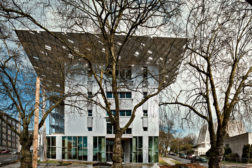Architectural Technology
The latest version of the widely adopted green building standard is set to debut in November with the most thorough overhaul since its inception. Here’s what you need to know.
Read More
Urban Agriculture Grows Up
A wave of rooftop greenhouses and vertical farms captures the imagination of architects while offering an alternative to conventional cultivation methods.
Read More
Dynamic Facades: Buildings Show Off New Moves
To enhance environmental performance and create dramatic visual effects, architects devise facades that adapt to changing conditions.
Read More
Guggenheim Face-Lift Retains Original Wrinkles
Restoration team tackles thorny preservation issues while preparing a 50-year-old architectural icon for its next half-century.
Read More
Acoustics in school building moves toward the head of the class
From cacophony in the schoolyard and tense quiet during finals to the social jungle of the cafeteria and the read-out-loud of Roald Dahl: Maybe no acoustic environment is expected to perform in such a variety of ways as the contemporary school.
Read More
Copyright ©2024. All Rights Reserved BNP Media.
Design, CMS, Hosting & Web Development :: ePublishing

